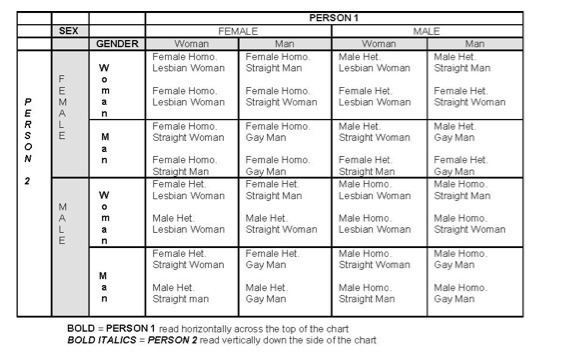 | ||
The gender taxonomy is a classification of the range of different levels at which humans vary in sexual characteristics. It is mainly used by medical specialists working in the area of sex research. John Money and Milton Diamond are probably the best known researchers in this field. Money earned his PhD for research into human hermaphroditism and pseudohermaphroditism, now known as intersex conditions. The taxonomy starts at the simplest, biological level and traces differentiations expressed at the increasingly complicated levels produced over the course of the human life cycle.
Contents
Gendered Sexuality Taxonomy
Contemporary definitions and conceptualizations of sex, gender, and sexuality lack sufficient subtlety to adequately describe the full range of human sexuality (Devor, 1994). A taxonomy of gendered sexuality, presented below, can better define the terms relevant to human sexuality and takes into account the interaction over time among sex, gender, and sexual fantasies, desires, practices of persons in intimate relationships at both the level of self-identity and attribution by others. The taxonomy is a combination of classifications based on the genetic sexes of persons in relationships and categorizations based on those persons' social genders to arrive at classifications of gendered sexuality. Terminology for this taxonomy was drawn from everyday language and can be used for descriptive, diagnostic, and theoretical purposes.
Biological Taxonomy
A taxonomy of gender also includes biological classifications of a range of sexual characteristics, which develop over one’s life cycle. The purely biological level of classifications includes chromosomes, which categorize female sex chromosome abnormalities and male sex chromosome abnormalities.
Turner Syndrome is a result from one of female sex chromosome abnormalities. Females inherit only one X chromosome (genotype is X0). Many do not survive birth and if they do they are shorter in stature and usually lack secondary female sexual characteristics. Their ovaries do not develop properly so they are sterile. If given estrogen replacement therapy around the age of puberty, women with Turner syndrome appear relatively normal.
Triple-X Syndrome is another syndrome that occurs from a female sex chromosome abnormality. Females inherit three or more X chromosomes (genotype is XXX). These “super-females” or “meta-females” appear normal except for their unusually long legs and slender torsos. They tend to be emotionally immature for their size but emotionally mature in relation to girls their same age. They sometimes have learning difficulties, usually in speech and language. Women with Triple-X syndrome are fertile but can have premature ovarian failure.
Klinefelter Syndrome is a syndrome resulting from a male sex chromosome abnormality. Males inherit one or more extra X chromosomes (genotype is XXY). They have higher-pitched voices with little facial and body hair. In childhood, they have learning difficulties and are more likely to be overweight. Boys are usually given testosterone at the age of puberty and often sterile. Men with Down syndrome sometimes also have Klinefelter syndrome.
XYY Syndrome is also a syndrome resulting from a male sex chromosome abnormality. Males inherit an extra Y chromosome (genotype is XYY). These “super-males” appear normal but are usually taller and produce higher levels of testosterone. In childhood they are more slender, have severe acne, are very uncoordinated, and have below average intelligence. Males with XYY syndrome are fertile and are not often aware that they have an abnormality.
Social Taxonomy
Taxonomies of gender can also include social classifications. The social classifications include erotic preferences, such as paraphilia. Paraphilia is defined recurrent sexual, intense, urges and sexually arousing fantasies generally involving nonhuman objects, the humiliation of oneself, partners, children, or other non-consenting individuals. It has also been determined to be a mental illness. There are several different types of paraphilias that exist and the DSM V includes seven specific paraphilias: exhibitionism, fetishism, frotteurism, masochism, sadism, voyeurism, and transvestite fetishism.
Exhibitionism is the recurrent urge or behavior to expose one’s genitals to an unsuspecting person.
Fetishism is the use of non-sexual or non-living objects to gain sexual excitement.
Frotteurism is the recurrent urges or behavior of touching or rubbing against a non-consenting person.
Masochism is the recurrent urge of behavior of wanting to be humiliated, beaten, bound, or in anyway made to suffer.
Sadism is the recurrent urge or behavior involving acts in which the pain or humiliation of the victim is sexually exciting.
Voyeurism is the recurrent urge or behavior to observe an unsuspecting person who is naked, getting undressed, or engaging in sexual activities or may not be sexual in nature at all.
